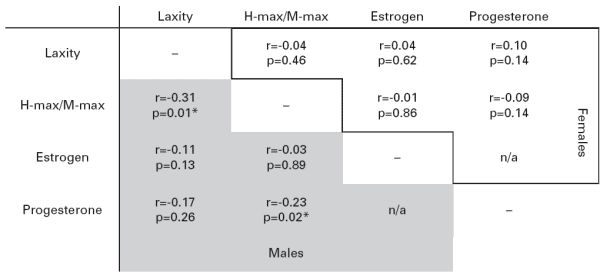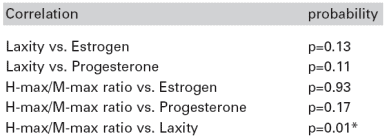|
PRACTICAL
SIGNIFICANCE
Based on
the data
in this
study,
fluctuating
concentrations
of
Estrogen
in the
female
is not
related
to
motoneuron
activity
or knee
joint
laxity.
STUDY
BACKGROUND
Despite
extensive
efforts
to
identify
the
mechanism
or
combination
of
mechanisms
responsible
for the
high
incidence
of
female
noncontact
ACL
injuries,
the
exact
etiology
remains
unknown.
Factors
such as
anatomical
differences
between
sexes,
neuromuscular
characteristics
of the
sexes,
and
hormonal
influences
in the
menstruating
female
have all
been
studied.
However,
no
studies
have
investigated
a
combination
of
hormone
levels,
neuromuscular
characteristics,
and knee
joint
laxity.
OBJECTIVE
The
purpose
of this
study
was to
determine
if
changes
in
estrogen
concentrations
over the
course
of the
menstrual
cycle
were
related
to
motoneuron
activity
or knee
joint
laxity.
DESIGN
AND
SETTING
Correlational
design
study
conducted
in the
Sports
Medicine
Laboratory
at
Oregon
State
University.
SUBJECTS
Twenty-eight
female
subjects
(mean
age=
22.4 ±
3.4 yrs)
who
reported
regular
menstrual
cycles
between
28 and
32 days
in
length
with no
more
than 3
days of
variation
over the
past 3
cycles
participated
in the
study.
Female
volunteers
were
excluded
if they
reported
the use
of
hormonebased
birth
control
within
the past
year.
Fifteen
male
subjects
(mean
age =
22.3 ±
3.7 yrs)
served
as the
control
group.
MEASUREMENTS
Saliva
samples,
Hoffmann
reflex
(H-reflex)
measurements,
and knee
joint
laxity
values (Compu
KT @
133.5 N)
were
obtained
each
testing
day.
Female
subjects
were
tested
every
other
day,
starting
on the
second
day of
their
cycle;
male
subjects
were
tested
every
fourth
day over
28 days.
Hormone
levels
(ESTROGEN
and
PROGESTERONE)
were
measured
using a
2 ml
saliva
sample
collected
via
passive
drool,
then
centrifuged
and
frozen
at –700
C for
later
analysis.
The
ratio of
the
Maximum
H-reflex
to
Maximum
M-wave (Hmax/Mmax
ratio)
in the
soleus
muscle
served
as the
H-reflex
outcome
measure.
Correlations
of the
outcome
variables
were
calculated
for each
subject
by
pairing
measurements
made on
the same
day.
One-sample
t-tests
were
used
separately
for male
and
female
data of
each
variable
to
evaluate
whether
the mean
correlation
differed
from
zero (?
= 0.05).
In
addition,
two-sample
ttests
were
used to
test the
difference
of the
male and
female
correlations
for each
variable.
Mean
correlations
and p
values
are
presented
in Table
1.
The
results
of the
test of
the
difference
of the
correlations
are
presented
in table
2.
RESULTS
Results
indicate
no
association
between
female
hormone
levels
and
motoneuron
activity
or knee
joint
laxity
during
the
menstrual
cycle.
Significant
correlations
between
H-max/Mmax
ratio
and both
progesterone
and knee
joint
laxity
in the
male
subjects.
In
addition,
not only
was the
correlation
between
Hmax/Mmax
ratio
and
laxity
significant
it was
significantly
different
from the
female
group’s
correlation.
CONCLUSIONS
Based on
the data
in this
study,
fluctuating
concentrations
of
Estrogen
in the
female
is not
related
to
motoneuron
activity
or knee
joint
laxity.
Future
research
in the
area of
hormones
must
investigate
how
other
mechanisms
combine
with
hormonal
factors
to
influence
put
females
at a
higher
risk for
ACL
rupture.
Table 1:
Correlation
Matrix

Table 2:
Test of
the
differences
of the
correlations
between
Males
and
Females

|
Publication
&
Presentation
List:
-
NATA
Annual
Meeting,
Baltimore,
MD,
June
15-19,
2004
|
|
|
|

Mark Hoffman, PhD, ATC
Rod Harter, PhD, ATC
Brad Hayes, MA, ATC
Principal Investigator |
Mark A. “Mark” Hoffman, PhD, ATC is an Associate Professor in the
College of Health and Human Sciences at Oregon State University. He received a PhD from Indiana University (Kinesiology, Motor Control Specialization, Neuroscience Minor) in 1997, an MA from San Jose State University (Physical Education, Athletic Training Specialization) in 1993 and a BS from Indiana University (Athletic Training/Sports Science) in 1991.
Mark A. “Mark” Hoffman, PhD, ATC
Associate Professor
Department of Exercise & Sport Science
Oregon State University
RM 104 Women’s Building
Corvallis, OR 97331-3303
541-737-6787 (office)
541-737-2788 (fax)
mark.hoffman@oregonstate.edu |
|
|
This
Grant
Information
Summary
may be
downloaded
in a
2-page
pdf file
from
http://www.natafoundation.org/PDF/Hoffman2.pdf. |
Back to
September
30, 2010
eBlast
Newsletter
Send e-mail
to teresa@nata.org with questions
or
comments
about this web site. |


